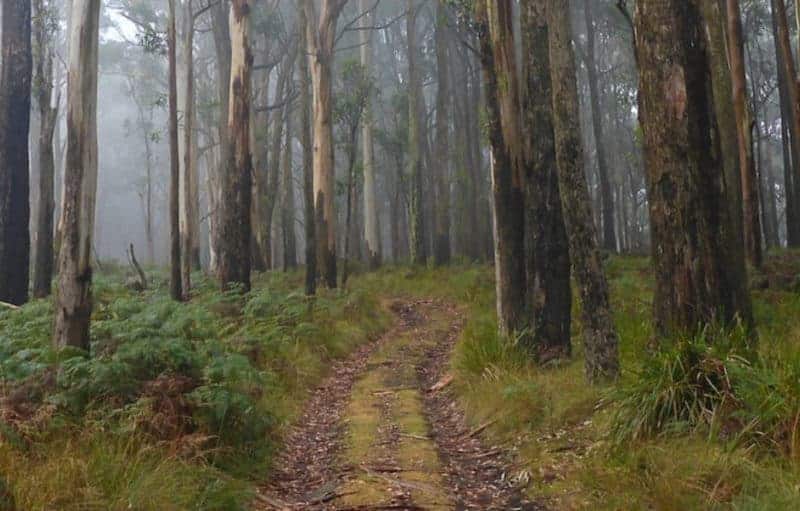Park Watch March 2020 |
In the tall trees of the Central West lives a quiet yet enigmatic creature, writes VNPA Nature Conservation Campaigner Jordan Crook.
During the day they curl up in a ball inside hollows. But at night this large animal comes out to glide from tree to tree in the highest canopy.
The Greater Glider (Petauroides volans) is the largest gliding mammal in Australia – and the second largest in the world! Growing to a metre in length, the Greater Glider really is a sight to behold from its long fluffy tail to its furry ears.
These forest-dependent marsupials call the forests of Australia’s east coast home, with a distribution from central Queensland to Victoria. The Wombat Forest near Daylesford, only slightly more than one hour from Melbourne, is its western-most range.
Sadly, populations in Victoria are in decline and the species is listed as threatened. In a 12-year period, their numbers have reducing by 50 per cent in East Gippsland, and by 8.8 per cent each year in the montane ash forests of the Victorian Central Highlands. This is due to habitat loss and fragmentation from clearing, logging and bushfires.
At least a quarter of Greater Glider numbers have been impacted by the unprecedented bushfires in the east of Victoria. This makes the protection of unburnt habitat vital to the species future.
Citizen scientists from Wombat Forestcare have been surveying Greater Glider populations in the Wombat Forests since 2010, and in that time they have documented 278 individual gliders in 212 records.
A recently released report commissioned by the Victorian National Parks Association and Wombat Forestcare crunched the numbers.
You can read the report Wombat Forest, A Greater Refuge for Gliders on our website.
The report reveals densities of Greater Gliders within the Wombat Forest are large and regionally significant. Similarly high densities in East Gippsland and the Strathbogie Ranges led to the protection of glider habitat in those locations in November 2019, as part of the conservation measures within the Victorian Greater Glider Action Statement.
The nearest population of Greater Gliders from Wombat Forest is 80 kilometres east in the Central Highlands. The Wombat Forest gliders should be seen as an ‘Insurance Policy’ for the species in Victoria, thanks to their relative isolation which means they could be safer in the context of landscape-scale fires, which will increase with our changing climate.
The high numbers of Greater Gliders in the Wombat Forest support the recommendation for permanent protection of this habitat. The proposed Wombat-Lerderderg National Park would secure the glider’s future in the west of the state. You can help support the creation of these new national parks and reserves in the central west here.
The Greater Glider is a wonder of the natural world and a true treasure of the Victorian bush – we must protect this loveable creature.
Help our Greater Gliders
Greater Gliders are quite rare – even rarer now after the bushfires have wiped out a large area of their habitat in Victoria (see coverage on the following pages). One in four of East Gippsland’s gliders appear to have died in the tragedy
Now, unbelievably, loggers want to cut down remaining forests that have not burnt.
Please help us protect these important refuges for Greater Gliders and our other precious wildlife.
Greatness knows no limits – facts about Greater Gliders
- Greater Gliders are nocturnal, largely silent and solitary.
- Their body grows up to 45cm, with a tail up to 60cm.
- Their soft fuzzy fur ranges in colour from pure white to black, with some mottled grey.
- A membrane of skin stretches between each elbow and ankle.
- They are able to glide more than 100 metres.
- Their body forms a triangle when gliding, and their tail is used for steering.
- Graceful in the air, they are clumsy on the ground.
- They prefer moist forest types and older trees with hollows for nesting.
- They feed only on gum leaves and buds from their favourite eucalypts.
- They rarely interact except when mating.
- Mature females will give birth to a single joey each year, typically in late autumn or early winter. It will suckle and develop in her pouch.
- Each adult inhabits up to twenty different dens in tree hollows within its home range.
- The individual’s territory will be larger and smaller, depending on the respective size of the patch of forest.
- Extra fun fact known to many citizen scientists: when spotted with a torch their eyes reflect a very bright light!
Did you like reading this article? Want to be kept up to date about this and other nature issues in Victoria? Subscribe to our email updates.
You can also receive our print magazine Park Watch four times a year by becoming a member. Find out more here.
